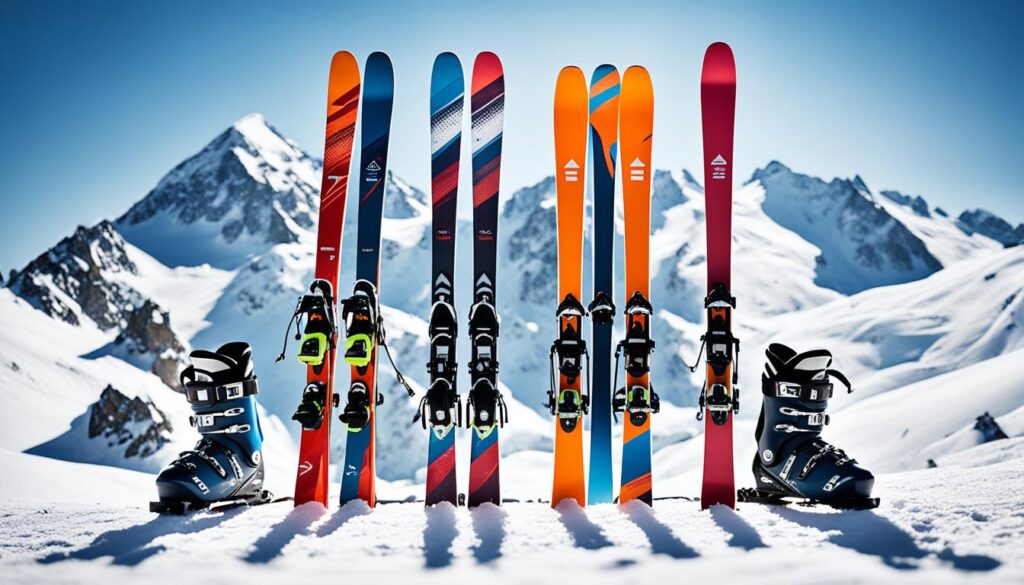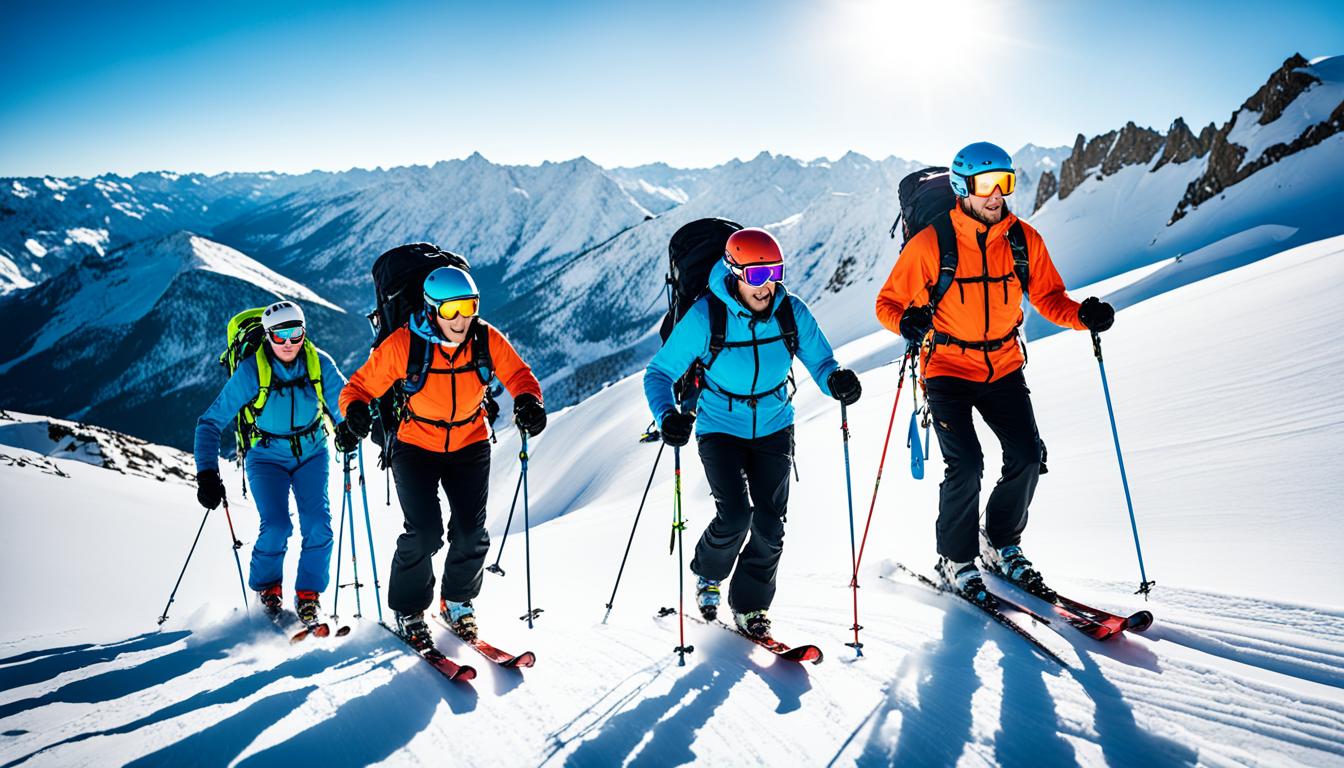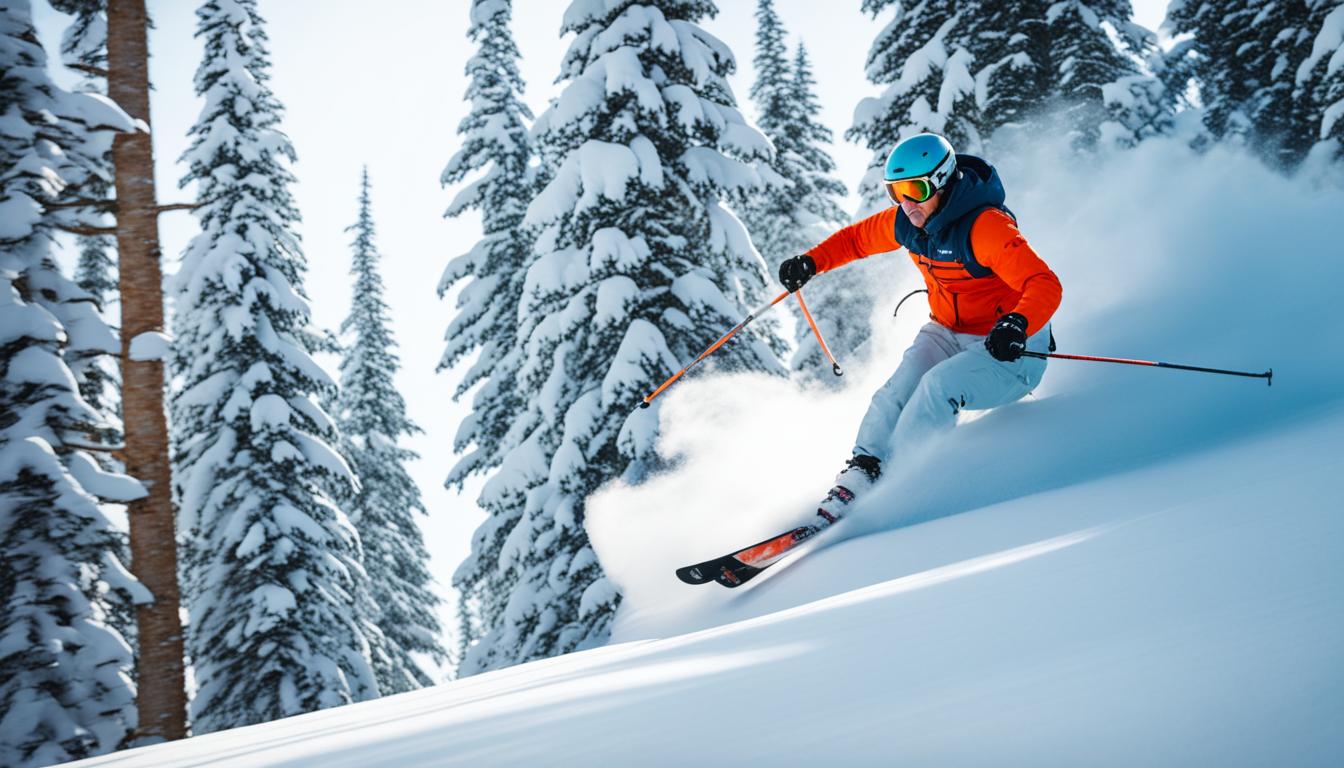Welcome to our comprehensive guide on advanced ski fitness and conditioning! As ski season approaches, it’s essential to prepare yourself physically for the slopes. We’ve partnered with Dr. Greg, a renowned expert in ski-related physical therapy, to bring you the ultimate preparation strategy. In this article, we’ll delve into ski workout routines, strength training exercises, and tips to improve your ski performance.
When it comes to skiing, being in top-notch physical condition is key to ensuring you can tackle any terrain with confidence and minimize mid-day fatigue. Dr. Greg emphasizes the importance of a tailored ski conditioning program to enhance your strength, stamina, and overall skiing abilities.
Key Takeaways:
- Invest time in a ski fitness regimen to improve your performance on the slopes.
- Follow specific ski workout routines that target the muscles used in skiing.
- Incorporate strength training exercises, such as squats, lunges, and deadlifts, to enhance your ski stamina.
- Consider adding advanced ski conditioning exercises that focus on agility, balance, and core strength.
- Optimize your ski equipment to enhance stability and control.
The Importance of Ski Conditioning for Peak Performance
Proper ski conditioning is vital for achieving peak performance on the slopes. Skiing requires strength, stamina, and agility to navigate various terrains and handle the forces of gravity.
Ski conditioning programs help improve muscular endurance, cardiovascular fitness, and overall ski-specific skills. By incorporating ski workouts and conditioning exercises into your training regimen, you can enhance your skiing abilities and reduce the risk of injury.
When it comes to ski conditioning, it’s crucial to focus on exercises that target the muscles used in skiing, such as quads, hamstrings, glutes, and core muscles. Strengthening these muscle groups not only improves your overall physical performance but also helps you maintain proper form and technique during your ski runs.
In addition to strength training, cardiovascular fitness is equally important for ski conditioning. Engaging in activities such as cycling, running, and HIIT workouts can improve your stamina and endurance, allowing you to ski longer without feeling fatigued.
Agility and balance are also key components of ski conditioning. Including exercises that challenge your balance, such as single-leg squats and lateral jumps, can help you stay stable and maneuver through various skiing situations.
Remember, ski conditioning is not just about physical fitness; it also involves mental preparation. Familiarize yourself with the terrain, practice visualization techniques, and set clear goals to enhance your overall ski performance.
Whether you’re a seasoned skier or just starting out, prioritizing ski conditioning in your training routine will undoubtedly make a significant difference in your performance on the slopes. So, lace up your boots, hit the gym, and get ready to conquer the mountains!
Ski Workout Routines for Strength and Stamina
Incorporating specific ski workout routines into your training can improve your strength and stamina on the slopes. By targeting the muscles used in skiing and enhancing your overall fitness, these exercises help you conquer the slopes with ease. Here are some effective ski workout routines to boost your athletic performance:
Strength Training Exercises
Strength training exercises are essential for building the muscular endurance necessary to tackle challenging slopes. Incorporate the following exercises into your routine:
| Exercise | Description |
|---|---|
| Squats | Aim for proper form and gradually increase weights to strengthen your legs and improve stability. |
| Lunges | Perform forward and lateral lunges to target different muscle groups and enhance balance. |
| Deadlifts | Focus on proper technique to engage your glutes, hamstrings, and lower back for improved power and stability. |
Cardiovascular Exercises for Stamina
Building stamina is crucial for skiing longer without experiencing fatigue. Incorporate the following cardiovascular exercises into your routine:
- Stair Climbing: Climbing stairs helps strengthen your legs and cardiovascular system, mimicking the demands of skiing.
- Stationary Bike: Pedaling on a stationary bike improves cardiovascular endurance while minimizing impact on your joints.
- Running: Incorporate running into your training regime to build endurance and improve overall stamina.
Remember to gradually increase the intensity and duration of your workouts to challenge yourself and continually improve.
“The more you train your muscles and cardiovascular system, the better equipped you’ll be to handle the physical demands of skiing.” – Dr. Greg
Don’t forget to include ample rest days in your training plan to allow your body to recover and adapt to the demands of your ski workout routines. Additionally, always prioritize proper form to prevent injuries and maximize the benefits of your training.
Next, we’ll explore advanced ski conditioning exercises that take your training to the next level. Stay tuned!
Advanced Ski Conditioning Exercises
To take your ski conditioning to the next level, we recommend incorporating advanced ski-specific exercises into your routine. These exercises focus on improving agility, balance, and core strength, all of which are essential for maintaining proper technique and control while skiing. By incorporating these exercises into your training regimen, you can enhance your ski performance and elevate your overall skiing experience.
Here are some examples of advanced ski conditioning exercises:
- 1. Lateral Jumps: This exercise helps improve agility and lateral movement, which are crucial for navigating turns and changing directions quickly on the slopes. Start by standing with your feet hip-width apart and then jump laterally to one side, landing softly on the opposite leg. Repeat on the other side.
- 2. Single-Leg Squats: Single-leg squats target your lower body muscles, including your quadriceps, hamstrings, and glutes, while also improving balance and stability. Stand on one leg and slowly lower your body into a squat position, keeping your knee aligned with your toes. Push back up to the starting position and repeat on the other leg.
- 3. Bosu Ball Exercises: Using a bosu ball can help improve balance and stability, mimicking the uneven terrain you may encounter while skiing. Stand on the rounded side of the bosu ball and perform exercises such as squats, lunges, and single-leg balance exercises.
- 4. Stability Ball Exercises: Stability balls are excellent tools for improving core strength and stability, which are vital for maintaining proper form and control while skiing. Incorporate exercises such as stability ball planks, mountain climbers, and Russian twists into your routine.
Remember to consult with a fitness professional or ski conditioning specialist before attempting these advanced exercises, especially if you’re new to them or have any existing injuries. They can provide guidance on proper form and progression to ensure you perform these exercises safely and effectively.

Adding these advanced ski conditioning exercises to your training routine can help you build the agility, balance, and core strength needed for an exceptional skiing experience. These exercises focus on the specific muscles and skills required for skiing, allowing you to maximize your performance on the slopes. Incorporate them into your training regimen and watch your ski abilities soar!
Tips for Advanced Ski Fitness and Conditioning
In addition to following a structured ski fitness and conditioning program, there are several tips that can help enhance your advanced ski training.
Set Specific Goals
Setting specific goals is essential for improving your ski fitness and conditioning. Whether it’s increasing your stamina, improving your strength, or mastering a specific ski technique, having clear objectives will keep you motivated and focused throughout your training.
Vary Your Workouts
To avoid plateaus and keep your ski training exciting, it’s important to vary your workouts. Incorporate different exercises, equipment, and training methods into your routine to challenge your body and continually progress. This variety will also help target different muscle groups and improve your overall ski performance.
Incorporate Interval Training
Interval training is a highly effective method for improving your ski fitness and conditioning. By alternating between periods of high-intensity exercise and rest or low-intensity exercise, you can boost your cardiovascular fitness, increase your endurance, and enhance your overall performance on the slopes.
Stay Consistent with Your Training Schedule
Consistency is key when it comes to advanced ski fitness and conditioning. Stick to a regular training schedule and make it a priority in your routine. By committing to consistent workouts, your body will adapt and progress, ultimately improving your ski performance.
Seek Professional Guidance When Needed
If you’re serious about taking your ski fitness and conditioning to the next level, consider seeking professional guidance. Working with a ski coach, trainer, or physical therapist can provide valuable insights, personalized training plans, and proper technique guidance to maximize your results.
The Role of Equipment in Ski Performance
While ski fitness and conditioning are crucial for improving performance, the role of equipment should not be overlooked. The design and quality of your skis, boots, and other gear can significantly impact your stability, control, and overall skiing experience. Investing in high-quality equipment that suits your skill level and skiing style can enhance your performance and reduce the risk of injury on the slopes.
When it comes to ski equipment, finding the right fit is paramount. Ill-fitting ski boots can lead to discomfort and reduced control on the slopes. It’s essential to get properly fitted ski boots that support your feet and allow for precise movements. Consider seeking professional guidance from a ski gear expert or boot fitter to ensure the best fit and maximize your performance.
Another crucial component of ski performance is your choice of skis. Different skis are designed for specific terrains, styles, and skill levels. For example, if you prefer carving turns on groomed slopes, a narrower ski with a shorter turn radius might be ideal. On the other hand, if you enjoy off-piste adventures, wider skis with better floatation can provide more stability and control in deeper snow.
Ski performance depends on a combination of factors, and having the right equipment plays a significant role in unlocking your full potential on the slopes.
It’s also worth considering the importance of bindings, poles, and other gear. Bindings that are properly adjusted to your boots can enhance safety and power transfer, ensuring optimal performance. Poles that are the correct length and suited to your skiing style can provide additional balance and stability.
When selecting ski gear, it’s essential to balance performance with personal preferences. Consider factors such as ski stiffness, shape, and camber profile based on your skill level and desired skiing style. Demo days or rentals can be a great opportunity to test different equipment before making a purchasing decision.

The Impact of Ski Equipment on Performance
The right ski equipment can enhance your performance in several ways:
- Ski Stability: Well-designed skis and boots provide better stability, allowing for smoother turns and improved control.
- Ski Performance: High-performance skis are designed to deliver optimal carving, edge grip, and responsiveness, enhancing your ability to push your limits on the slopes.
- Safety: Properly fitted ski boots, bindings, and other gear reduce the risk of injuries by providing adequate support and protection.
Investing in quality ski equipment tailored to your needs can make a significant difference in your skiing experience. Whether you’re a beginner or an advanced skier, choosing the right gear is a crucial step towards optimizing your performance on the slopes.
| Equipment | Role |
|---|---|
| Ski Boots | Provide support, control, and power transfer to the skis |
| Skis | Affect stability, maneuverability, and performance |
| Bindings | Secure boots to skis and enable efficient power transfer |
| Poles | Assist with balance and timing during turns |
| Other gear (helmets, goggles, etc.) | Provide protection and enhance comfort on the slopes |
Recovery and Injury Prevention in Ski Conditioning
Proper recovery and injury prevention strategies are essential components of any ski conditioning program. At SlopesFit, we prioritize your well-being and ensure that you stay in top form throughout the ski season. By incorporating ski stretching, warm-up exercises, and cool-down routines, you can minimize the risk of injuries and optimize your performance on the slopes.
The Importance of Ski Stretching
Ski stretching plays a crucial role in preparing your muscles for the physical demands of skiing. It not only increases flexibility but also improves your range of motion, allowing you to move freely and effortlessly. By integrating stretching exercises into your pre- and post-ski routines, you can prevent muscle soreness and enhance your overall athletic performance.
The Art of Ski Warm-up
Before hitting the slopes, it’s essential to warm up your body to increase blood flow and activate your muscles. A proper ski warm-up routine can enhance your agility, coordination, and reaction time. Engaging in dynamic movements like leg swings, walking lunges, and arm circles can help loosen your muscles, increase joint mobility, and prime your body for the exhilarating ski adventure ahead.
The Benefits of Ski Cool-down
Many skiers overlook the importance of a cool-down routine after a day on the slopes. However, incorporating a ski cool-down into your post-ski regimen is equally vital. It helps your body gradually transition from high-intensity activity to a state of relaxation, promoting muscle recovery and reducing the risk of post-exercise soreness. Consider incorporating stretching exercises, foam rolling, and gentle movements to aid in the rejuvenation process.
“Proper recovery and injury prevention are key to maintaining optimal performance and ensuring longevity in your skiing journey.”
By prioritizing ski recovery, injury prevention, and incorporating stretching, warm-up, and cool-down techniques into your ski conditioning program, you can optimize your performance and keep yourself injury-free throughout the ski season. At SlopesFit, we’re here to support you in your quest for peak skiing performance.
Conclusion
Advanced ski fitness and conditioning are crucial for improving performance, reducing the risk of injury, and elevating your overall skiing experience. By following a well-structured ski conditioning program, incorporating ski-specific workouts, and optimizing your equipment, you can enhance your strength, stamina, and agility on the slopes.
Remember to prioritize recovery and injury prevention to ensure longevity in your skiing journey. Incorporate stretching, foam rolling, and other recovery techniques into your routine to reduce muscle soreness and improve flexibility. Warm up and cool down before and after skiing to prevent injuries and prepare your body for the physical demands of the sport.
With dedication and consistency, you can elevate your slopes game and take your skiing abilities to new heights. Set specific goals, vary your workouts, and seek professional guidance when needed. By optimizing your training approach and investing in high-quality equipment, you can improve your ski fitness and conditioning for better performance on the slopes.
So get ready to hit the slopes and conquer the mountains with enhanced strength, stamina, and agility. With the right ski conditioning program and a focus on recovery and injury prevention, you’ll be well-equipped to enjoy a thrilling and rewarding skiing experience.
FAQ
Why is ski conditioning important for peak performance?
Ski conditioning is vital for achieving peak performance on the slopes. It improves muscular endurance, cardiovascular fitness, and overall ski-specific skills, reducing the risk of injury.
What are some ski workout routines for strength and stamina?
Squats, lunges, deadlifts, and plyometric movements can enhance strength, while stair climbing, biking, and running can improve endurance and stamina.
What are advanced ski conditioning exercises?
Advanced ski conditioning exercises include lateral jumps, single-leg squats, bosu ball exercises, and stability ball exercises. These exercises improve agility, balance, and core strength.
Any tips for advanced ski fitness and conditioning?
Set specific goals, vary your workouts, incorporate interval training, stay consistent, and seek professional guidance when needed to optimize your training approach.
How does equipment impact skiing performance?
High-quality skis, boots, and other gear enhance stability, control, and overall skiing experience, reducing the risk of injury on the slopes.
What should I prioritize for recovery and injury prevention in ski conditioning?
Incorporate stretching, foam rolling, warm-up, and cool-down exercises to reduce muscle soreness, improve flexibility, and prevent injuries before and after skiing.




